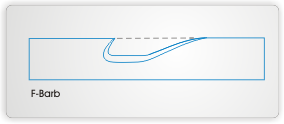BARB STYLES
Barbs basically fall into two categories: conventional cut barbs and F-Barbs which protect the fibres. Conventional barbs are made with the use of the barb cutters. The product is a hook with relatively sharp edges that damages, to a greater or lesser degree, the fibres. Needles with this kind of barb are used primarily for needling recycled fibres because, in this case, the value for money is essential.
To manufacture fibre-protection barbs, so-called F-Barbs, high-precision tools are employed. These tools help to produce round-edged barbs suitable for felting and ensuring fibre protection. These barbs wear out differently from conventional barbs. Their lifetime is much longer. This helps to produce a more regular product over longer production periods. For very dense fibres (1 dtex is the acronym for decitex, which is equivalent to the weight in grams of 10,000 metres of yarn) or spun-bonded fibres, these barbs are absolutely necessary to minimise the fibre damage and finally to achieve the required strength and quality properties of the non-woven fabric.


DISTANCES BETWEEN THE BARBS
KOPTEX offers the following distances between the barbs:
| RB | (Regular Barb) | = | 6,3 mm |
| MB | (Medium Barb) | = | 4,8 mm |
| CB | (Close Barb) | = | 3,3 mm |
WORKING BLADE LENGTH
(TRIANGULAR PART)
As a rule, the length of the working blade for RB needles is 28 mm, although RB needles with the working blade length of 22 mm are also manufactured. These needles have only two barbs on each side of the triangle.
The standard length of the working blade of MB and CB needles is 22 mm, but needles with the working length of 19 mm are also manufactured.

